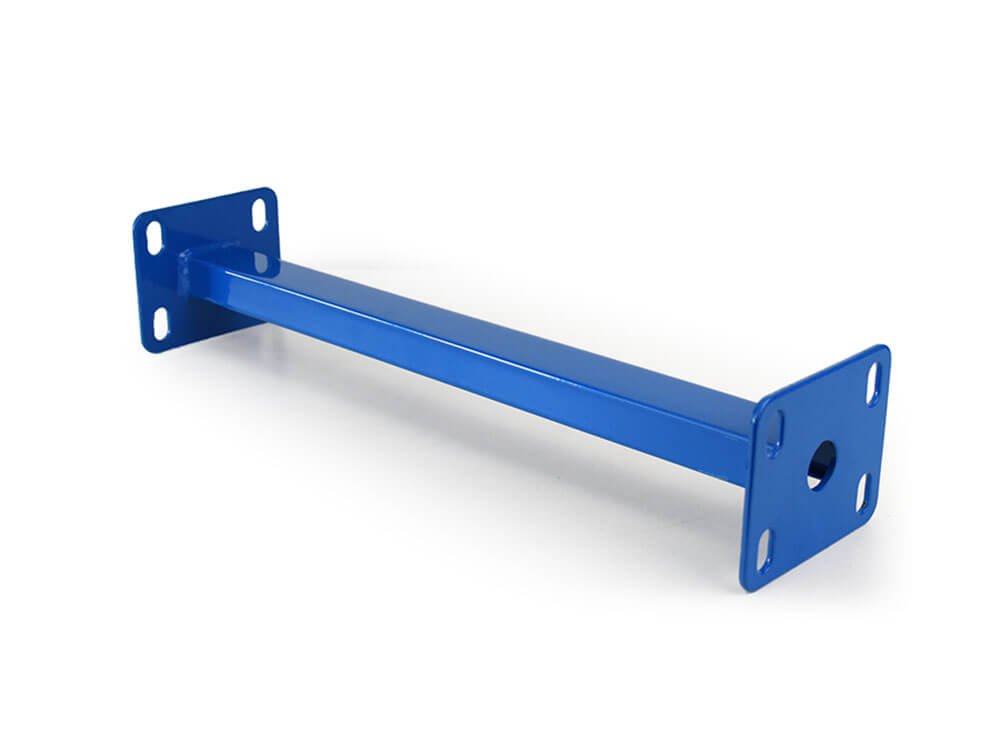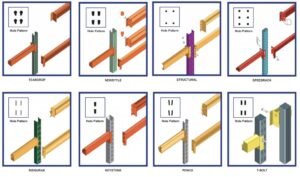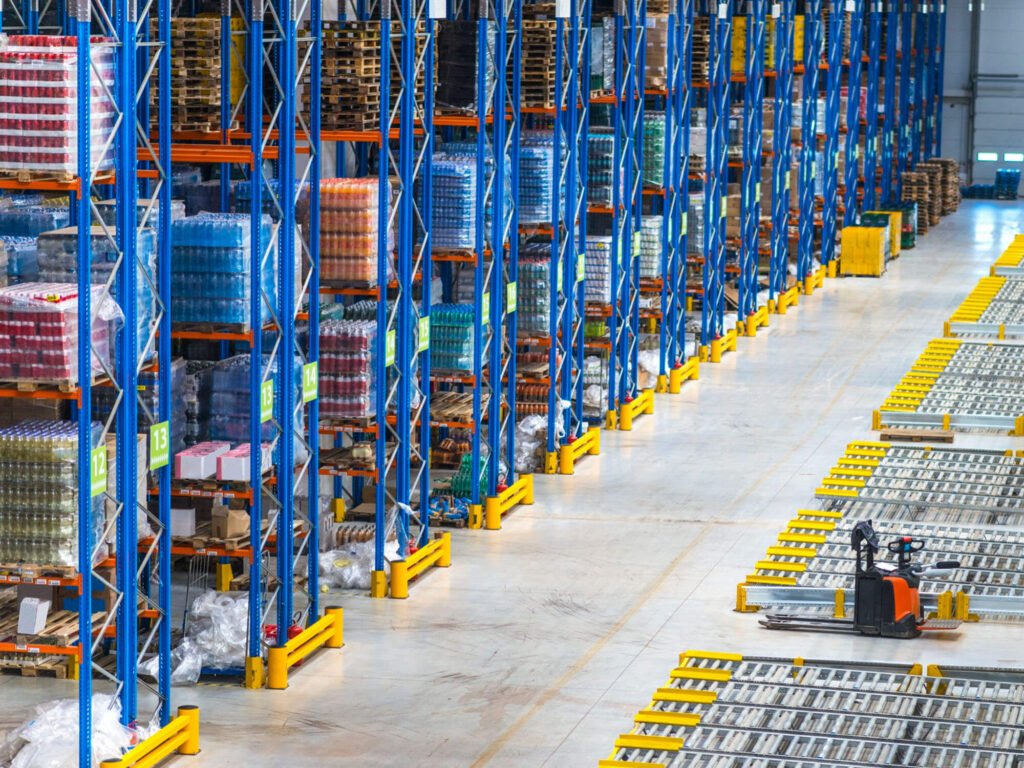Pallet racks are indispensable components of every storage facility, facilitating efficient and organized inventory. Without them, warehouses could experience rock-bottom storage capacity. On the contrary, warehouses that know how to utilize pallet racks will achieve marvelous inventory performance.
To get the most out of pallet racks, you first need to know what they are, what role they play in warehouses, and, most importantly, understand in detail what components make a pallet rack.
If you are interested in learning about this storage system and its essential parts, you have knocked on the right door. This article is all about breaking down the intricacies of pallet racking systems, from beams to braces. Without further ado, let’s dive right in!
Defining A Pallet Racking System
Also known as pallet racks, a pallet racking system is a warehouse storage solution created for handling pallets containing goods in an accessible and organized manner. This tool forms, together with pallets and forklifts (or other handling equipment), an important trio for every warehouse.
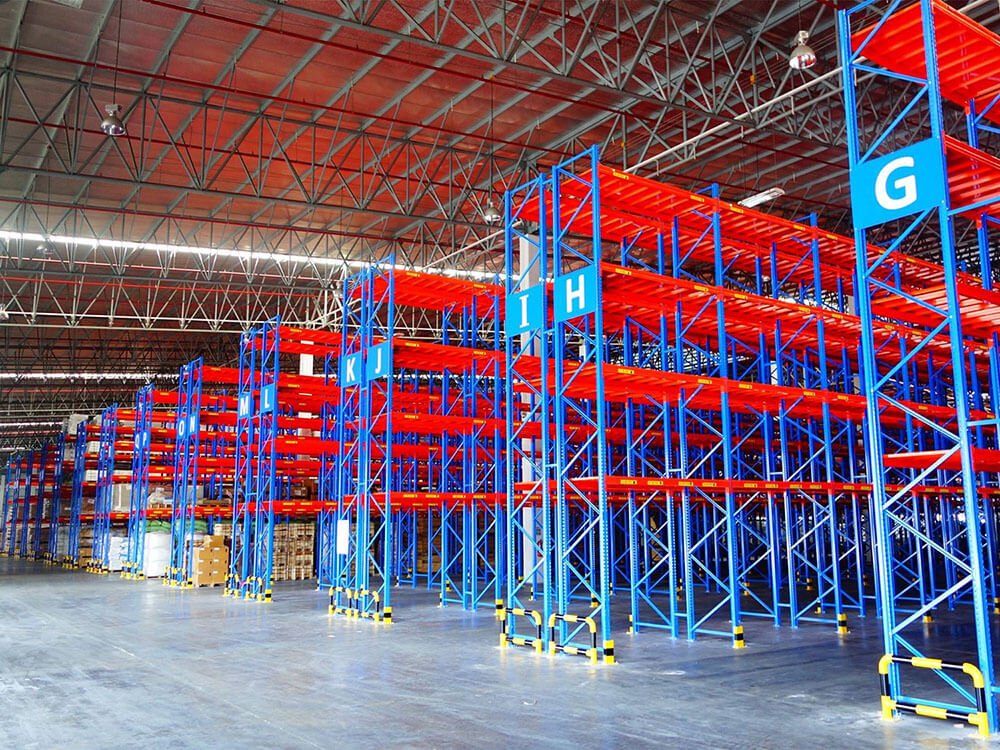
From static to mobile, there is a wide array of pallet rack types to choose from, depending on your storage needs and your goods characteristics. Some of the most popular options include selective racks, push-back racks, and drive-in racks.
Understanding The Role Of A Pallet Racking System
Pallet racks are not decorative items. Having the right kind in your warehouse will inevitably boost storage capacity and performance. This is all thanks to the following wonderful roles of pallet racks:
- Maximizing vertical space: Thanks to the vertical structure, pallet racks allow businesses to make the most of their vertical space. Companies can stack pallets vertically to utilize available cubic feet and store a larger quantity of goods.
- Enhancing accessibility: Pallet racks are created to facilitate effortless access to stored items. This design helps render more efficient inventory management while reducing the time it takes to locate and retrieve items.
- Streamlining goods handling: Thanks to pallet racks, inventory can now be organized systematically, allowing businesses to control stock levels better. The tools also help prevent stockouts or overstock situations.
- Cost-effective, safe, and durable: A properly installed and maintained pallet rack will reduce warehouse costs significantly and enhance the facility’s safety. It is also a durable option that can withstand the large weight of palletized goods.
A Comprehensive Guide To Pallet Racking Parts
If you take a detailed look at pallet racks, you will notice that these storage solutions are more than just upright frames and beams. There are various components, some of which are really small, that form a full rack.
Let’s take a look at all the essential parts of a pallet racking system via the following anatomy. For simplicity, the below content will focus on selective pallet racks only.
Uprights
Uprights, or upright frames, are the backbone of every pallet racking system. These vertical columns help support the pallet rack’s entire weight and thus ensure the system’s strength and integrity.

It takes at least two uprights to form a selective pallet racking system. And despite its simple look, this component actually comes in various sizes and styles. Each feature will render distinct effects in the uprights.
Uprights’ Sizes
Uprights are characterized mostly by their sizes, which include their depth, width, and height. While uprights’ width is fixed at 3 inches to make the calculation of the racking row length easier, their heights and depths vary with many options.
Typically, uprights’ height ranges from 8 inches to 24 inches and is crafted in 2-inch increments. There is no standard figure for this dimension. Any height will work as long as it gives the rack enough strength to hold the intended pallets.
Regarding the uprights’ depth, this number often runs from 24 inches to 72 inches. However, 36-inch, 42-inch, and 48-inch are the most popular choices. These three options, respectively, are ideal for 42-inch, 48-inch, and 56-inch deep pallets (as having 3 inches of overhang on each side of the rack is a standard practice).
Uprights’ Materials
Most uprights are made of steel, thanks to this material’s firmness and strength. Depending on how the steel is handled in the production process, you will have two different upright types: (1) structural steel uprights and (2) roll-formed steel uprights.
The difference between the two types above lies in the early stage of the upright manufacturing process.
While structural steel uprights are formed by pouring molten steel into a mold and letting it cool, the making of roll-formed steel uprights begins with feeding steel pieces through multiple roller dies and letting them be bent into their eventual finished shape.
Generally, structural steel uprights are more durable and impact-resistant, which makes them ideal for extreme storage environments. But roll-formed steel uprights are more popular, thanks to their versatility and affordable prices.
Upright’s Styles
Uprights are designed to connect with beams and other components to form a complete pallet rack. And they do that via multiple holes across their surfaces. Professionals often scrutinize the shape of these punched holes to tell which style the uprights are.
There are many upright styles available on the current market, some of which include slotted, rectangle t-bolted, round-hole hex head, and keystone. But the most sought-after style is the teardrop pallet racking.
This upright style has its holes shaped like upside-down teardrops, which explains its name. Normally, these punched holes are 2 inches in length and connect with beams via hooks to form the support connection.
Beams
If uprights are vertical structures, beams are horizontal bars attached firmly to two uprights (via the upright’s punched holes). Beams serve the function of providing a support surface on which the pallets are stored and joining contiguous uprights.
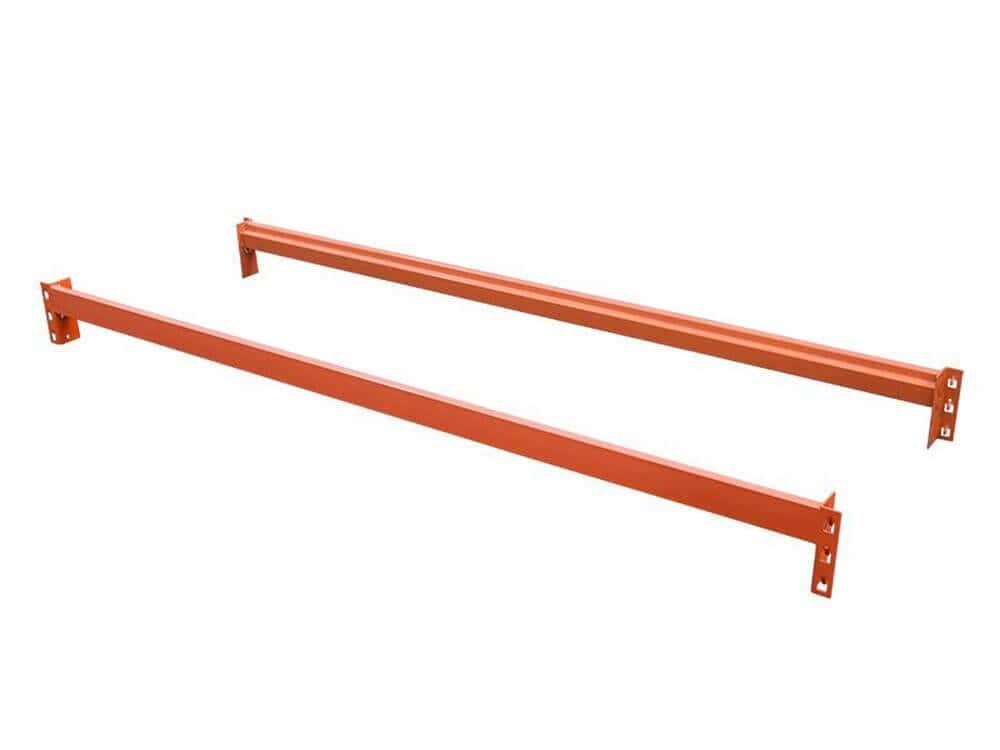
Similar to uprights, beams are also made of steel. This material gives the component optimal durability and strength to carry heavy loads.
Beams’ Sizes
Pallet racking beams are available in various heights and lengths.
Firstly, let’s talk about beam height. This number shows you how heavy the beam is and determines the pallet rack’s capacity. The heavier the beam, the more weight it can withstand. However, the cost will become higher as well. Typically, beam height ranges from 2.5 inches to a little over 6 inches.
The other beam’s dimension is an important metric that decides how many pallets you can store on a racking row. Beams can span from 48 inches long to 168 inches long, which is equivalent to two or three 48-inch-wide pallets. For selective pallet racks, 96-inch beams are the most popular.
Beam Types
There are two common ways to categorize pallet racking beams. The first one is based on the design, with the following two beam types:
- Box beams: This beam type is known for its rectangular box shape with no inset step. It is usually mounted onto the uprights with rivets or clips.
- Step beams: Characterized by the L-shape design, this beam type is usually roll-formed from one piece and contains a ledge with connectors being welded onto both beam’s ends.
The second way to classify beams is by their exterior finish. This approach provides you with two main beam types, as follows:
- Galvanized beams: As the name suggests, this beam version possesses a hot-dip galvanized finish. During the manufacturing phase, the beam is soaked entirely in a zinc bath to prevent it from corroding. Thus, it is a great choice for outdoor warehouses or demanding storage environments.
- Painted beams: This is undoubtedly the most common beam variation out there. Unlike the galvanized type above, this kind of beam has a painted finish, with orange as the most recognizable color option.
Rack Braces
Just like beams, rack braces are metal struts that join the front and rear uprights together, both horizontally and diagonally. However, if beams help support the heavy weights from goods and pallets, braces’ mission is to prevent the pallet racks from collapsing by providing additional stability.

When talking about pallet racking braces, you need to know about the brace panels. This concept refers to how the struts are arranged vertically throughout the upright’s height. D-brace, K-brace, Z-brace, and X-brace are the four most widespread brace panel patterns.
In addition to brace panels, you also need to pay attention to brace thickness and the number of struts. All these configurations depend on your seismic standards and the distance between two adjacent beam levels.
Pallet Rack Footplates
Also known as baseplates or footpads, footplates are affixed to the upright’s underside. This part serves as an anchor and contributes extra stability to your entire pallet racking system by providing a sturdy foundation for the vertical columns.
Shims
When placing pallet racks on uneven warehouse floors, you will need shims to level the structure and prevent the racks from wobbling. Shims are small plates made of plastic or steel and often installed under uprights.
Safety Components Of Pallet Racking Systems
In addition to the basic components above, pallet racking systems also comprise many other parts designed to maximize warehouse safety and the racking structure’s integrity. Here are some common safety components of a pallet racking system:
Upright Protectors
Upright protectors are one of the most important safety accessories for pallet racks. Installed on every external upright, these protectors play a pivotal role in absorbing impact from accidents and collisions (maybe from forklifts) and minimizing damage to the storage structure.

Thanks to this safeguard function, businesses can significantly reduce their repair costs and maintenance efforts. There are various upright protectors on the market, depending on their installation spots. Some popular types include:
- Reinforced upright protectors: Besides the conventional version that is secured to the warehouse floor, reinforced upright protectors are pieces of plastic or metal attached to the uprights themselves. They are useful in safeguarding the higher part of the upright leg.
- Side frame protectors: Typically connected to floor-mounted upright protectors, these C-shaped elements provide additional protection in the external frames’ lower area. They can be made of steel or wood.
- End-of-aisle protectors: Unlike other versions, end-of-aisle protectors shield the entire pallet rack’s depth (instead of just a single upright) from harmful collisions. In most cases, they are installed at the end of each warehouse aisle, where forklift operation is more intense.
Safety Pins
If you take a closer look at the connecting spots of beams and uprights, you will notice a small, j-shaped piece there. Professionals call it a safety pin, but j-pin is a more user-friendly name.

J-pins are key elements in maintaining the overall safety of the racking structure. They do it by preventing clip-on beams from accidentally being disconnected from uprights.
Such scenarios can arise during the loading and unloading procedures. When raising a pallet, forklifts could unintentionally lift the beam above and unclip it from the upright. As a result, pallets on that higher level will fall, leading to accidents and the rack’s collapse.
Pallet Backstops
Pallet backstops are another safety measure you can acquire for your pallet racking system. These components prevent loaded pallets from falling into the back of the rack, or flue space, due to unexpected impacts, especially with push-back racks.
Besides the core function above, pallet backstops also maintain enough flue space between racking rows to allow for proper fire suppression and ventilation. In addition to the upright-mounted type, there are also pallet stoppers secured to the warehouse floor.
Anti-Collapse Mesh
Another element that prevents your pallets from accidentally falling off the back of your rack is anti-collapse mesh. Unlike the rigidity of pallet backstops, these meshes offer flexible protection that fits various storage environments.
Not only do they support pallet overhang, but anti-collapse meshes also act as a reliable fence to warn operators against hazardous materials or dangerous machinery. These protective elements come in various sizes and apertures to comply with different health and safety requirements.
Row Spacers
Row spacers, or back connectors, are another detail you often miss when browsing warehouse pictures. These pallet racking components are horizontal bars that connect two uprights from back-to-back racking rows.

This connection creates a gap between rows of pallet racks that enables forklifts or other warehouse equipment to function in an easy and safe way. This gap is also useful to prevent accidents or collisions between adjacent racking rows.
Common Signs Of Pallet Racking Parts
It’s safe to say that you have gone over almost everything in a pallet racking system. However, the list would be incomplete if safety signs were left untouched. Therefore, let’s explore the following two signs that are often utilized in pallet racks.
Aisle Signs
These rectangular markers display internal ID codes and are normally placed at the beginning or end of each aisle. They help warehouse operators locate pallet racking positions more quickly, as well as what items are being stored there.
In most warehouses, aisle signs are often painted in highly visible colors, such as white, yellow, green, or red. Besides the bolted version, some aisle signs come with a magnetic or adhesive strip to facilitate quick mounting.
Capacity Notice Signs
Warehouse operators can also quickly pick up information about load capacities and weight limits with capacity notice signs. These small guidebooks ensure that every pallet rack is utilized within its designed limits and prevent overload situations.
Most capacity notice signs are rectangular and made of PVC. They are secured to each racking system’s end to make sure warehouse operators and technicians can see them.
Other Pallet Racking Add-Ins For Storing Non-Palletized Goods
This section introduces other add-ins you can install in racking systems to meet your specific inventory demands. Please note that these add-ins are designed to support the storage of non-palletized goods.
Shelf Panels
Shelf panels are essential components when it comes to storing non-palletized goods. Positioned with the beams, shelf panels provide an extra horizontal level within the racking structure to hold products above.
Manufacturers produce shelf panels in various materials to best accompany your goods. Below is a short list of some typical shelf types based on materials:
- Steel shelves: As the name suggests, these shelf panels are made of steel and thus supply a firm surface for depositing non-palletized loads. Not only are they robust, but they also allow quick assembly, thanks to the boltless design.
- Mesh shelves: Compared to steel shelves, this variation is more lightweight as it is made of welded wire mesh. Additionally, mesh shelves are durable and give great visibility, which minimize the time to spot and locate stored products.
- Chipboard shelves: Also known as boards, these wooden elements attach firmly to beams via retainers at both ends. It is recommended to use chipboard shelves in conjunction with support bars to achieve maximum load capacity.
Support Bars
Often perpendicularly secured to the pallet racking beams, support bars form a bottom layer to support the above pallets, including non-standard and weakened ones. These components are also applicable for non-palletized cargoes.

Additionally, support bars enhance warehouse safety as they provide better airflow and sprinkler access. They are also handy in case pallets are not placed on both the front and rear beams. However, it requires at least two support bars beneath each load.
Pallet Rack Cradles
When it comes to storing cylindrical loads, drum beds are the go-to selection. This component comprises two V-shaped metal bars secured parallel to the beams to immobilize your special loads.
By holding the cylindrical units (such as drums and coils) in place, these cradles allow warehouse operators to handle the loads more safely and easily.
Summary Table
Besides the vast information (including gritty-nitty details) provided above, you can utilize the following summary table as a shortcut to understanding the overall structure of pallet racking systems.
| Category | Pallet Racking Parts | Key Takeaways |
|---|---|---|
| Basic components | Uprights | Vertical columns that support the rack’s entire weight. |
| Beams | Horizontal bars that join contiguous uprights and hold pallets. | |
| Rack Braces | Two V-shaped metal bars are attached to beams that support the storage of cylindrical items. | |
| Footplates | Attached to the upright’s underside and provide extra stability. | |
| Shims | Metal struts, horizontally or diagonally, join the front and rear upfronts, preventing pallet racks from collapsing. | |
| Safety components | Upright protectors | Cover uprights for protection against warehouse collisions. |
| Safety pins | J-shaped elements that help prevent clip-on beams from accidental disconnections from uprights. | |
| Pallet backstops | Additional horizontal beams that safeguard pallets from falling into the back of the rack. | |
| Anti-collapse mesh | A more flexible protection option to prevent goods from falling off at the back of the rack. | |
| Row spacers | Small, horizontal bars that connect back-to-back racking rows, enabling space for forklift maneuvers. | |
| Information signs | Aisle signs | Display ID codes that help spot racking rows positions more quickly. |
| Capacity notice signs | Display the weight limits or load capacities of each pallet rack to operators. | |
| Optional add-ins | Shelf panels | Supply a horizontal level within the racking structure to hold non-palletized items. |
| Support bars | Bars that are placed perpendicularly to beams and support the storage of weakened pallets and non-palletized items. | |
| Pallet Rack Cradles | Two V-shaped metal bars attached to beams that support the storage of cylindrical items. |
Conclusion
In conclusion, when it comes to keeping your warehouse running smoothly, it’s all about choosing the appropriate pallet racking system. And to do that, you must have a solid understanding of those pallet racking parts.
This article has walked you through all the nitty-gritty details that make a pallet rack. So, whenever you think of upgrading storage systems for your facilities, feel free to refer to this content here to find the most suitable components for your inventory demands.

